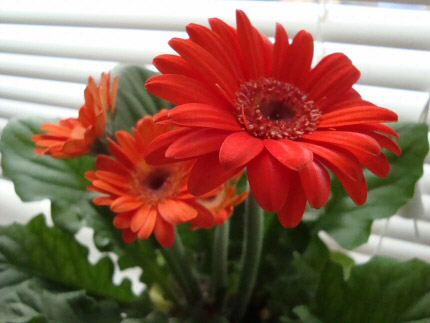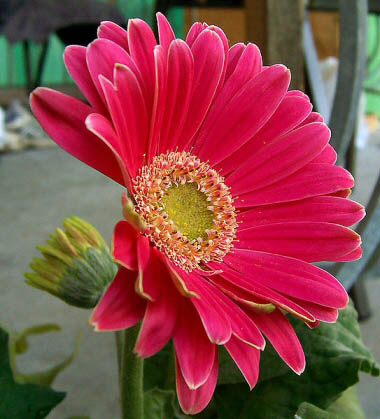





The Gerbera Daisy or Transvaal Daisy is a pot plant that is related to the familiar white and yellow daisies that you find growing outside in the lawn. Except this one is much bigger, has a variety of different coloured blooms and is one of the most frequently used cut flowers around the world when it comes to flower arranging.  It was named in 1889 after the German botanist Traugott Gerber, who was good friends with the plant naming expert Carl Linnaeus.
It was named in 1889 after the German botanist Traugott Gerber, who was good friends with the plant naming expert Carl Linnaeus.
When grown outdoors it's "easy" but as a houseplant it becomes "difficult". That said it's still an easy care houseplant for the most part and even with poor care over a prolonged period Gerbera's don't give up easily. The main problem is that this plant is only really wanted when it's flowering. At all other times it lacks attraction and so unless you can find beauty in the average looking leaves, it might not be a houseplant you want around for very long if it's not in flower.
The good news is that it produces new flowers quite profusely with the correct care. The only difficult part therefore is getting the flowers to return and this is because Gerbera's need sun in order to produce the colorful flowers, but sunshine or bright light shinning through windows produces a lot of heat which Gerbera's struggle with.
Ultimately unless you can meet the care requirements detailed below a Gerbera indoors is often treated as a pot plant. Much like the Poinsettia, Chrysanthemum or Hyacinth, you enjoy the blooms for several months before either discarding the plant or transplanting it into the garden. However if you can provide bright light along with average temperatures you could potentially have it some where in your home all year round as flowers are produced regularly. If you would like to give it a go at making it a permanent guest we explain more here.
Light
These plants must have good bright light if you expect repeat blooming, but direct harsh sunlight can quickly damage your Gerbera, by scorching the leaves and increasing the temperature to very high (and undesirable) levels.
If your intended placement receives full sun for a few hours a day this should be acceptable, although you will have to accustom the Gerbera to it over a few days. If you just plonk it down in such a place expect it to go into shock.
Watering
Try to water often in warmer months of the year. In these months you want moist, rather than dry or soaking, soil. Take care to avoid splashing the leaves, like African Violets it's best to water from the bottom, or around the sides rather than over the leaves, as doing this can encourage various fungal diseases. You'll need to water a lot less when things are cooler as the plant won't use or need as much water.
Humidity
The humidity you find in most homes is more than sufficient. However avoid very humid places such as bathrooms.
Feeding
Feeding is quite important if you plan to keep your Gerbera as a permanent houseplant. Look for a fertiliser which is high in Potassium (or Potash) such as a tomato feed, to encourage repeat flowering, however you can also make do with a general all purpose formula. Feeding once a month following the manufacturers instructions should be plenty.
Temperature
Cool to average temperatures will keep the plant in bloom for longer and encourage repeat flowering.
Cool to average temperatures should be your aim: 7°C - 18°C / 45°F - 65°F . The flowers will last a lot longer and you'll increase your chances of repeat blooms in the long run.
Repotting
Standard commercial potting soil is suitable when you repot. You can do it at anytime of the year and the next container should only be slightly bigger than the last. There is obviously no need to repot if you're only treating the plant as colorful temporary house guest.
Propagation
The flowers produce seeds which you can try and germinate in Spring, although they will often not come true, i.e. the new plants wont look the same as it parents. Fortunately almost all pot plants are reasonably priced and it is usually more economical to just nip out and buy yourself a new one if needed. You'll know what you're getting flower wise and the Gerbera is already fully grown and at a flowering size, where as one grown from seed could take up to a year or more to reach this stage.
Speed of Growth
Green growth is fast when young plants are maturing, but older plants tend to grow a lot slower as they are spending their energy producing new flowers.
Height / Spread
As a houseplant Gerberas rarely grow above 60cm / 24in high and "spread" wise you are looking at no more than 45cm / 18in.
Flowers
Unlike some flowering houseplants, the leaves of the Gerbera are a little "weed-like" in appearance, so the eye grabbing flowers are of great importance to drawn attention away from the leaves.  The large daisy-like blooms rise above the plant on strong stems, typically lasting for several weeks or sometimes longer if temperatures are on the cool side.
The large daisy-like blooms rise above the plant on strong stems, typically lasting for several weeks or sometimes longer if temperatures are on the cool side.
The blooms which can be singles or doubles come in many different colours, white, cream, yellow, pink, salmon and red. It's common for several blooms to appear over a period of weeks with more emerging from the centre of the plant after the first flush is fading, this prolongs the time it's in flower. Deadhead (remove) the spent blooms on your Gerbera to stop the plant spending time and energy producing seeds, this will keep the plant looking tidy and also encourage it to produce more flower buds.
Anything Else?
Given ideal conditions you can expect flowers to appear for much of the Summer. If you plan to keep them for the following year, either as a houseplant or a garden plant you will need to "over winter" them in a semi-bright, cool but frost-free place. Keep them barely moist. When Spring comes and the danger of frost has past, you can can ether plant them outdoors or move to a brighter spot in your home.
Copyright © www.100flowers.win Botanic Garden All Rights Reserved